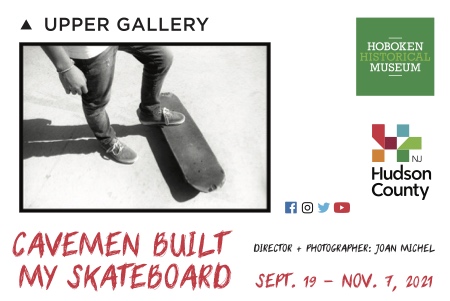Joan Michel – “Cavemen Built My Skateboard”
September 19, 2021 - November 7, 2021

Joan Michel is an award-winning professional photographer-filmmaker with an impressive list of clients in the fashion world and other businesses. After starting her photography studies at School of Visual Arts in New York nearly a decade ago, she recently completed her Bachelor of Arts degree at New Jersey City University, majoring in Media Arts with a concentration in film making.
Jersey City born and raised, Michel began pursuing a passion to interpret the world through a lens in high school, when she bought her first digital SLR camera. While at SVA, she learned to appreciate the unique qualities of working with analog film, which informs the way she shoots even when using digital equipment.
Her final thesis project, completed earlier this year, was inspired by her interest in skateboarders. She produced a fascinating film, “Cavemen Built My Skateboard,” about a young skateboarder, Iggy Manzanero, whom she met in Jersey City. Impressed as much by his warmth and openness as by his dedication to perfecting his skills, Michel captures this special young man’s character in a short film that showcases her skills with a variety of shooting styles and techniques. Her artist’s statement about the project appears below.
The show in the Museum’s Upper Gallery is based on stills from the film, which can also be viewed on YouTube. Learn more about Michel’s work by visiting her website at www.joan-michel.com.
My project, “Cavemen Built My Skateboard,” has been a process from March to August 2021. The subject was a 16-year-old named Iggy Manzanero.
During Covid-19, my therapist recommended that I do something my younger self always wanted to do and I told her I always wanted to skateboard. So going to the skate park is where I met Iggy in 2020 and he encouraged me to go out there, skate and have fun. I was taken aback because I was just a stranger to him at first and he showed his kind-hearted personality, which to me was the total opposite of the stereotypical skater. I believe it’s rare to meet kind people, so if you do, you keep them close because it’s a cruel world out there—or maybe that’s just me being traumatized.
I kept an eye on him for months at the skate park and then approached him about this project. It’s not about being the best skater for me, it’s about the importance of being a good human. He mentioned he has never worked on something like this, and because he is a minor, I had to ask his mother for permission to document him.
I did my research and bought many photo books related to skateboarding. I’ve even contacted other photographers/directors who film skate videos to ask for advice on how to capture and print the photos I want. Artists who inspired me were Greg Hunt, Rafael Gonzales, Spike Jonze, French Fred, Ari Marcopoulos, and many more. I even reached out to pro skaters, and talked to the local skaters in Jersey City to practice when I wasn’t photographing/filming Iggy.
I recorded him on 16mm, Super 8 motion picture film, and also captured him on color and black-and-white film. It was a struggle doing everything by myself and at times I had to shoot with multiple cameras so I wouldn’t miss the shot. It taught me how to multitask in a way I never knew I could accomplish. It was also a pretty expensive production, so I ended up creating a crowdfunding campaign for the first time. I was able to raise $7,500 in a month! It opened my eyes to how many people out there believe in my vision and want to see what I make come to life.
I’m very thankful for Iggy’s patience with my process and with doing tricks over and over again until he landed them. Sometimes under the hot sun, it would get tiring and exhausting even for myself but we kept going. Especially when we both got physically hurt, we still kept going, and I think that’s what people admired the most as they were witnessing the process of filming and taking photos for this project. There was a lot of preparation in figuring out what film stocks to use, in which locations, and factoring in the weather and our schedules.
After every weekend, I would go to the lab and drop off my film, then pick it up, and scan the images at home. I would study what I needed to improve on and what was missing in the sequence of my photos. I would then plan out how to execute and capture the missing pieces for the next shoot. I decided to photograph with film stocks such as Kodak Colorplus and Portra for color film, because it offered the greatest saturation, since I usually shoot during a sunny day. I felt the vibrant colors worked with the action and movement I was trying to capture as he skated.
Despite all the work and struggles, it was rewarding to see the results in the end. It was also exciting for me to see the images come to life in print. Being in the darkroom created an even deeper connection for me with my work. I had to look closely at all the details to do the color correction and adjust the sharpness to get an accurate image. I felt sentimental when the project finally came to a close.
The exhibit is supported by a block grant from the State/County Partnership program for the Arts, administered by the Hudson County Division of Cultural and Heritage Affairs.
